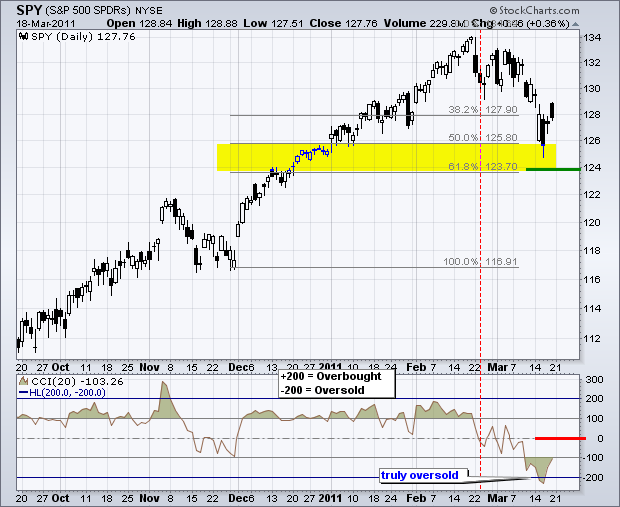Even though the indicator summary turned negative on Friday (minus 3) for the first time since September 3rd, the decline over the last four weeks is still considered a correction within a bigger uptrend. This 6% decline follows a 13.5% advance since late November and a 30% advance since late August. After retracing 50-62% of the November-February advance and becoming very oversold, the ETF found support around 125 and bounced the last two days. This move reinforces support in the 124-126 area on the daily chart. The Thursday-Friday bounce was a bit tentative and there could be another test of support in this area.

On the 60-minute chart, SPY gapped up on Thursday and Friday. There were afternoon pullbacks, but these gaps are largely holding. With the stock futures pointing sharply higher on Monday morning, another gap is likely and the oversold bounce could extend to the broken support zone around 129.5-130.5. This zone also marks a 50-62% retracement of the prior decline (±134 to ±125). RSI remains in bear mode and will likely challenge resistance in the 60-65 area in the next day or two.

Key Economic Reports/Events:
Mon - Mar 21 - 10:00 - Existing Home Sales
Tue - Mar 22 - 10:00 - FHFA Housing Price Index
Wed - Mar 23 - 07:00 - MBA Mortgage Index
Wed - Mar 23 - 10:00 - New Home Sales
Wed - Mar 23 - 10:30 - Crude Inventories
Thu - Mar 24 - 08:30 - Initial Claims
Thu - Mar 24 - 08:30 - Durable Orders
Fri - Mar 25 - 08:30 - GDP Estimate
Fri - Mar 25 - 09:55 - Michigan Sentiment
Charts of Interest: Tuesday and Thursday in separate post.
-----------------------------------------------------------------------------
This commentary and charts-of-interest are designed to stimulate thinking. This analysis is not a recommendation to buy, sell, hold or sell short any security (stock ETF or otherwise). We all need to think for ourselves when it comes to trading our own accounts. First, it is the only way to really learn. Second, we are the only ones responsible for our decisions. Think of these charts as food for further analysis. Before making a trade, it is important to have a plan. Plan the trade and trade the plan. Among other things, this includes setting a trigger level, a target area and a stop-loss level. It is also important to plan for three possible price movements: advance, decline or sideways. Have a plan for all three scenarios BEFORE making the trade. Consider possible holding times. And finally, look at overall market conditions and sector/industry performance.

About the author:
Arthur Hill, CMT, is the Chief Technical Strategist at TrendInvestorPro.com. Focusing predominantly on US equities and ETFs, his systematic approach of identifying trend, finding signals within the trend, and setting key price levels has made him an esteemed market technician. Arthur has written articles for numerous financial publications including Barrons and Stocks & Commodities Magazine. In addition to his Chartered Market Technician (CMT) designation, he holds an MBA from the Cass Business School at City University in London.
Learn More





